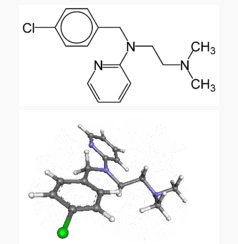Chloropyramine
 | |
| Clinical data | |
|---|---|
| ATC code | |
| Identifiers | |
| PubChem CID | |
| E number | {{#property:P628}} |
| ECHA InfoCard | {{#property:P2566}}Lua error in Module:EditAtWikidata at line 36: attempt to index field 'wikibase' (a nil value). |
| Chemical and physical data | |
| Formula | C16H20ClN3 |
| Molar mass | 289.803 |
|
WikiDoc Resources for Chloropyramine |
|
Articles |
|---|
|
Most recent articles on Chloropyramine Most cited articles on Chloropyramine |
|
Media |
|
Powerpoint slides on Chloropyramine |
|
Evidence Based Medicine |
|
Clinical Trials |
|
Ongoing Trials on Chloropyramine at Clinical Trials.gov Trial results on Chloropyramine Clinical Trials on Chloropyramine at Google
|
|
Guidelines / Policies / Govt |
|
US National Guidelines Clearinghouse on Chloropyramine NICE Guidance on Chloropyramine
|
|
Books |
|
News |
|
Commentary |
|
Definitions |
|
Patient Resources / Community |
|
Patient resources on Chloropyramine Discussion groups on Chloropyramine Patient Handouts on Chloropyramine Directions to Hospitals Treating Chloropyramine Risk calculators and risk factors for Chloropyramine
|
|
Healthcare Provider Resources |
|
Causes & Risk Factors for Chloropyramine |
|
Continuing Medical Education (CME) |
|
International |
|
|
|
Business |
|
Experimental / Informatics |
Editor-In-Chief: C. Michael Gibson, M.S., M.D. [1]
Overview
Chloropyramine is a classical ("old" or first generation) antihistamine drug approved in some Eastern European countries for the treatment of allergic conjuctivitis, allergic rhinitis, bronchial asthma, and other atopic (allergic) conditions. Related indications for clinical use include Quincke's edema, allergic reactions to insect bites, food and drug allergies, and anaphylactic shock.
Chloropyramine is known as a competitive reversible H1-receptor antagonist (also known as an H1 inverse agonist), meaning that it exerts its pharmacological action by competing with histamine for the H1 subtype histamine receptor. By blocking the effects of histamine, the drug inhibits the vasodilation, increased vascular permeability, and tissue edema associated with histamine release in the tissue. The H1-antagonistic properties of chloropyramine can be used by researchers for the purposes of blocking the effects of histamine on cells and tissues. In addition, chloropyramine has some anticholinergic properties.
Chloropyramine's anticholinergic properties and the fact that it can pass through the blood-brain barrier are linked to its clinical side effects: drowsiness, weakness, vertigo, fatigue, dryness in the mouth, constipation, and rarely - visual disturbances and increase of intraocular pressure.
Clinical dosage and administration
In cases of severe allergic reactions, chloropyramine can be injected intramuscularly or intravenously. Oral administration: In adults, 25 mg can be taken 3 to 4 times daily (up to 150 mg); in children over 5 years-old, 25 mg can be taken 2 to 3 times daily. For external application, the skin or the conjuctiva of the eye can be treated up to several times a day by applying a thin layer of cream or ointment containing 1% chloropyramine hydrochloride.
Contraindications
Contraindications for parenteral or oral administration include adenoma of the prostate, acute peptic ulcer, pyloric and duodenal stenosis, glaucoma, pregnancy, breast-feeding.
Special warnings and precautions
Chloropyramine should not be used internally with alcohol, sedative drugs and hypnotics because of the potentiation of the effects. It should be used with caution in patients suffering from hyperthyroidism, cardiovascular diseases, and bronchial asthma. In children, it can induce agitation, and in many adult patients dizziness may be observed. Because of the pronounced sedative effect the preparation should be prescribed cautiously in drivers and people working with machines.
Drug interactions
Chloropyramine should not be used internally with MAO inhibitors. Because of its anticholinergic activity, concurrent administration with cholinomimetics is not advisable. General anesthetics, analgesic agents and psycholeptics potentiate the sedative effect of chloropyramine. Template:Antipruritics
- Pages with script errors
- E number from Wikidata
- ECHA InfoCard ID from Wikidata
- Chemical articles with unknown parameter in Infobox drug
- Chemical articles without CAS registry number
- Articles without EBI source
- Chemical pages without ChemSpiderID
- Chemical pages without DrugBank identifier
- Articles without KEGG source
- Articles without InChI source
- Articles without UNII source
- Drugs with no legal status
- Articles containing unverified chemical infoboxes
- Drug
- Antihistamines